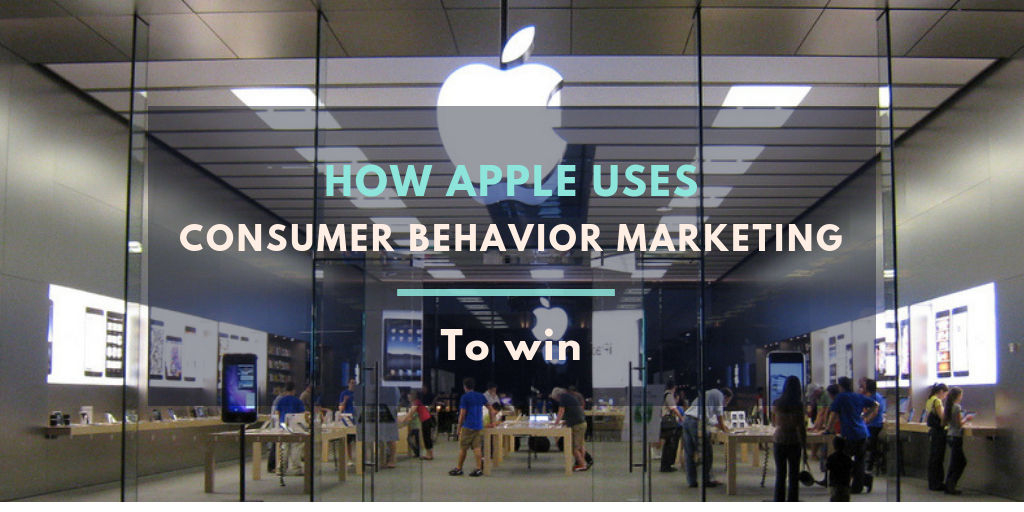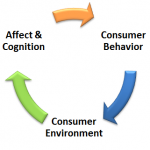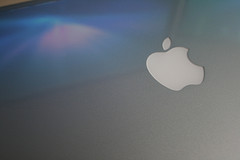Consumer behavior marketing is an essential ingredient in the current business climate. The companies that apply this type of marketing well have a distinct competitive advantage that distances them from their rivals.
Consumer behavior research is the primary driver at the core of any good strategy. Research provides actionable insight and ensures business success.
If you answer no to the following questions, this post is for you?
- Are you applying consumer behavior marketing currently?
- Have you conducted consumer behavior research within the last two years?
- Do you have consumer behavior marketing in your marketing plan with well-defined marketing strategies and tactics?
- Are you achieving the maximum results for your organization?
Every business has a target audience and consumer behavior marketing provides the fundamental methods for understanding your target. Consumer behavior research provides the underlying element that drives quality strategies and ensures business results.
This quote defining marketing sums up the importance of consumer behavior from David Meerman Scott, marketing authority, online marketing strategist, speaker, and best-selling author.
“Marketing is understanding your buyers really, really well. Then creating valuable products, services, and information especially for them to help solve their problems.”
– David Meerman Scott
The organizations that have an intimate understanding of their target audience possess a competitive advantage over those that do not. Establishing a one-to-one relationship and thorough knowledge of your target audience is a core responsibility for business in the 21st century and beyond.
Regardless if you are B2B, B2C, B2G or a hybrid organization you have a target audience. The information in this post can be applied to any business type.
This post focuses on Apple (B2C) employing consumer behavior marketing as a critical ingredient for their success.
Consumer Behavior Marketing at Apple
Have you ever wondered why Apple is so successful? They were not the first company to invent the personal computer, portable music device, the tablet, the smartphone, software to download music, or the set-top box to name a few. Apple has amassed a brand loyal following like no other brand backed by significant sales, market share, and profitability. So, how does Apple do it? What’s the secret behind their success?
Marketing using consumer behavior insight is how Apple succeeds. Even though Steve Jobs and Apple, did not use consumer research in the initial development of most products, consumer behavior plays a huge role in their marketing and ultimately the success of the company. Once a consumer purchases a product or downloads iTunes Apple has access to data the company leverages. Apple uses this information to gain significant insight into the consumer and what drives purchase behavior.
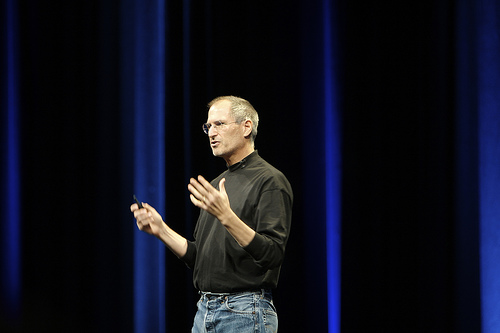
Photo by acaben  For the sake of this post, we will focus on consumer behavior at a high-level and how Apple communicates to detail how the company has gained a competitive advantage using consumer behavior throughout its marketing.
For the sake of this post, we will focus on consumer behavior at a high-level and how Apple communicates to detail how the company has gained a competitive advantage using consumer behavior throughout its marketing.
The Wheel of Consumer Analysis
Understanding concepts of consumer behavior at a high-level involves a framework to gain actionable insight from consumer research. The wheel of consumer analysis provides a framework to study consumer behavior consisting of:
- Affect and cognition
- Consumer behavior
- Consumer environment
Research focused on the consumer provides specific insight involving affect and cognition, consumer behavior, and the consumer environment that the company can use to reach its target audience effectively guiding the knowledge structure and decision process of the consumer.
Now let’s discuss the three areas of the framework.
Affect
In psychology, the affective system is defined as the way individuals respond to outside stimuli. The affective system in an individual is purely reactive and includes moods, emotions, and any other special feelings that may ignite a physical reaction. According to Peter and Olson, “Because it can account for many of the responses that environmental stimuli elicit from individuals, classical conditioning has important implications for marketing and consumer behavior”.
Apple and Affect
For example, the brand assets especially the brand logo changed in 1998 is sleek and modern chrome color (monochromatic) aligned with the direction that Steve Jobs had for the company upon his return in 1997. The new logo repositioned the brand effectively for a new century in the mind of the consumer retaining the shape of the apple and modifying the rainbow color to chrome creating an affective response from consumers’.
In a 2008 study by Duke University, it was reported that the Apple monochromatic logo made individuals more creative and stimulated the brain based on exposure to the logo. Apple does an amazing job of leveraging their brand assets such as the logo and brand messages across all communication channels and products in its ecosystem.
Cognition
The cognitive system performs mental processes including understanding, evaluating, planning, deciding, and thinking. Cognition is defined as a consumer’s knowledge, meanings, and beliefs about Apple, in this case, based on experience and retained memory. The feelings, moods, evaluations, emotions of the affective system are related to the cognitive system and effect cognitive processes (knowledge, meanings, and beliefs).
The Major Functions of Cognition
The major functions of an individual’s cognitive systems include interpretation and the ability to process interpretations to execute cognitive activities. Consumer decision-making consists of cognitive processes including;
- Interpretation
- Integration of knowledge
- Retrieval of product knowledge from stored memory used in the integration process
The insight obtained from consumer behavior research is critical in the development of effective cognitive marketing strategies that resonate with the target audience. An understanding of how consumers interpret marketing strategies, the consumer integration process, and activation of product knowledge result in critical insight for Apple. Apple uses this insight to market its products and retain their competitive advantage in the marketplace.
The consumer research Apple conducts related to cognition provides an understanding of how the target audience acquires and stores memory along with other important memory factors such as shopping scripts or product schemas. The types of knowledge (general or procedural) that the different marketing strategies and tactics activate are also important elements that influence marketing strategy.
Apple and Cognition
The company occupies a certain cognition based on Apple creating a context for their products focused on developing an eye-catching, simple design, and ease of use for complex technologies resulting in significant benefits for the consumer. Apple also positions each product emphasizing its innovations and communicating differentiated benefits to its consumers effectively.
Consumer Behavior
According to Peter and Olson, leading authorities in consumer behavior marketing and authors of Consumer Behavior & Marketing Strategy, “Behavior refers to the physical actions of consumers that can be directly observed and measured by others”. Understanding, analyzing, and influencing consumer behavior leads to sales and profits ultimately.
Apple and Consumer Behavior Marketing
Apple’s hardware devices are supported by the iTunes software. Hardware devices are purchased through online and offline retailers, and a limited number of retailers providing a tight vertically-integrated ecosystem. Using its integrated channels including online, retailer point of sale, and iTunes, Apple captures detailed information about consumer behavior.
A detailed understanding of Apple’s customers allowed the company to analyze consumer behavior more effectively. Apple uses this insight to tailor products and brand messages that resonate with the target audience making products that work better and are simple to use.
Consumer Environment
A consumer’s environment is based on the social and physical attributes of the world around them that includes spatial relationships, physical objects, and the social behavior of other individuals.
The physical environment including influences such as reference groups and online and offline retail environments also have a large impact on Apple’s success. The Apple retail environment, word of mouth, product experience, and Apple’s mission and values play a large part influencing the purchase behavior of Apple products in the marketplace.
Apple and the Consumer Environment
A major supplier of big-box retailers, Apple has branded stores that are the number one competitor for these large companies. The brand loyalty of Apple dominates the physical environment and therefore captures significant attention and focus in the retail (consumer) environment.
Apple and Other Retailers
To gain a competitive advantage in the physical environment, Apple uses strict control over key elements. Apple dictates pricing and how their products are displayed with retailers and especially with big-box retailers.
Apple Branded Stores
To create a unique customer experience Apple uses branded stores. The Apple store creates an interoperability between its hardware devices such as computers, tablets, smartphones, music players and watches that showcase capabilities such as video, music, photography, apps, and software.
The Apple branded stores leverage product knowledge and complementary services. The in-store experience includes one-on-one tutorials, product repairs, and workshops to provide an unparalleled customer experience.
The complementary services enhance the value proposition because if a customer can operate a new purchase then customer satisfaction will increase. Apple uses this among many other devices to dominate in the physical environment.
Apple and the Digital/Mobile Environment
The iTunes software developed by Apple has transformed the way people consume media. The new consumption methods for music, video, photography, and apps has allowed Apple to rule the digital and mobile landscape. Apple’s focus on the customer experience takes data from iTunes and other sources. The data is used to update the software and lock in brand loyalty.
Apple’s strategic presence in the retail, digital, and mobile landscape demonstrates how Apple captures and holds the consumer in the physical environment.
Apple’s obsession with consumer behavior and customer experience drives provides the central focus for the company. Consumer behavior marketing explained using the wheel of consumer analysis provides a context to explain Apple’s success. The way that Apple communicates its marketing messages using an integrated marketing communications (IMC) approach provides the complementary method for Apple to achieve success.
How Apple Communicates
Golden Circle Theory
Simon Sinek’s Golden Circle theory of how successful organizations communicate describes why Apple’s marketing communication resonates with its target audience. The central idea of the golden circle theory is, people do not buy what a company does, people buy why they do it.
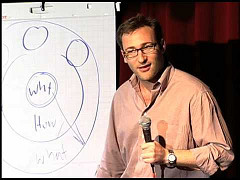
The Golden Circle theory provides evidence of how most companies communicate in an uninspiring manner. Most companies typically communicate by stating what they do, how a company is different or better, and the expectation from the company of a behavior, such as a purchase.
The Golden Circle theory focuses on the following elements:
- Why as a central focus in the inner circle
- The How is the next outer circle
- The What is the outermost circle
The why is the cause, purpose, or belief of the organization, according to Sinek, very few companies know why they are in business. Sinek cites Apple’s former CEO Steve Jobs vision of design and simplicity guiding how Apple does things and what they produce.
A sample marketing message Sinek gives from Apple states,
“Everything we do, we believe in challenging the status quo. We believe in thinking differently. The way we challenge the status quo is by making our products beautifully designed, simple to use and user-friendly. We just happen to make great computers. Want to buy one?”.
Shared Beliefs
Apple’s method of communicating provides consumers’ with trust, confidence, and a set of shared beliefs inspiring people to make a purchase from the company. The how refers to the actions a company takes to bring the beliefs into reality. The what are the resulting actions, such as the services, products, culture, marketing, and employees.
As a result of its marketing communication strategies, consumers have confidence they are purchasing a quality product whether, it is a Mac, iPhone, iPad, iPod or iTunes software. The shared beliefs between Apple and consumer’s along with positive product and service experiences are critical in establishing the brand in the mind of the consumer.
Please click play on the video below to view Simon Sinek explaining his Golden Circle Theory in his famous Ted Talk.
Conclusion
Consumer behavior marketing is a core competency of any successful organization in the current business environment. The primary driver at the core of any good strategy is consumer behavior research providing actionable insight and ensuring business success.
Regardless if you are B2B, B2C, B2G or a hybrid organization, you have a target audience. The information in this post can be applied to any business type.
Apple provides an excellent case study of an organization that uses consumer behavior marketing. Apple is an example of how research leads to successful marketing strategies and tactics. The result is a distinctive competitive advantage that drives meaningful business results.
The Golden Circle theory explains how Apple and other companies successfully communicate in a way that resonates with their target audience.
This post gives you the fundamental concepts of consumer behavior marketing and the Golden Circle theory to help drive bottom-line results for your business.
